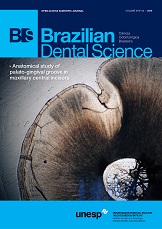Effect of the inclusion procedure on the alteration of teeth position in maxillary complete dentures
DOI:
https://doi.org/10.14295/bds.2015.v18i3.1139Abstract
Introduction: The dimensional alterations of denture base jeopardize adaptation and retention associated to altered occlusion, which are considered relevant factors for fabrication of complete dentures. Objective: The aim of this study was to evaluate linear tooth displacement during processing of maxillary complete dentures submitted to two inclusion methods and conventional polymerization. Material and method: Twenty maxillary complete dentures were fabricated: G1 – inclusion with silicone barrier, and G2 – inclusion with dental stone type IV barrier. Points were marked on incisal surface of right central incisor and cusp of second molars to allow linear measurement of the replicas through the software AutoCAD. The evaluation of artificial teeth displacement for both groups was carried out in different moments: a) waxed denture; b) waxed denture partially invested with stone or silicone barrier; c) after complete flasking; d) denture into flask after polymerization; e) denture attached to the cast after deflasking; f) denture separated from the cast; g) denture after finishing and polishing; h) denture after storage in water at 36° during 7 days. Result: Linear alterations occurred on artificial teeth positioning for both groups and in all periods of inclusion, with higher alterations for group G2. The data from phases c and d were significant different from other phases when compared intra groups, for both inclusion methods evaluated. Conclusion: Group G2 exhibited the greatest alterations. After polymerization, group G1(Inclusion with silicone barrier complemented with dental stone type III) demonstrated higher distance between the points (expansion) while group G2 revealed reduced distance (contraction).
Downloads
Downloads
Published
How to Cite
Issue
Section
License
Brazilian Dental Science uses the Creative Commons (CC-BY 4.0) license, thus preserving the integrity of articles in an open access environment. The journal allows the author to retain publishing rights without restrictions.
=================




























